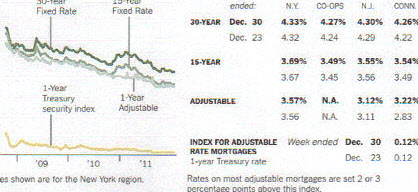New Residential Construction in December 2011
For information about distinguished Southern California luxury real estate in Los Angeles County, as well as coastal Orange County homes and San Diego homes, call Bob Cumming of Keystone Group Properties at 310-496-8122. Keystone Group Properties serves discriminating buyers and sellers of California exclusive real estate in Newport Beach, Laguna Beach, and Marina Del Rey homes; Manhattan Beach, Hermosa Beach, and Pacific Palisades homes; Mission Viejo, Redondo Beach, Santa Monica, Malibu, along with exclusive Los Angeles homes in Beverly Hills and Beverly Glen California.
U.S. Census Bureau News
Joint Release
U.S. Department of Housing and Urban Development
NEW RESIDENTIAL CONSTRUCTION IN DECEMBER 2011
The U.S. Census Bureau and the Department of Housing and Urban Development jointly announced the following new residential construction statistics for December 2011:
BUILDING PERMITS
Privately-owned housing units authorized by building permits in December were at a seasonally adjusted annual rate of 679,000. This is 0.1 percent (±1.2%)* below the revised November rate of 680,000, but is 7.8 percent (±2.2%) above the December 2010 estimate of 630,000.
Single-family authorizations in December were at a rate of 444,000; this is 1.8 percent (±1.2%) above the revised November figure of 436,000. Authorizations of units in buildings with five units or more were at a rate of 209,000 in December.
An estimated 611,900 housing units were authorized by building permits in 2011. This is 1.2 percent (±1.3%)* above the 2010 figure of 604,600.
HOUSING STARTS
Privately-owned housing starts in December were at a seasonally adjusted annual rate of 657,000. This is 4.1 percent (±11.6%)* below the revised November estimate of 685,000, but is 24.9 percent (±18.3%) above the December 2010 rate of 526,000.
Single-family housing starts in December were at a rate of 470,000; this is 4.4 percent (±11.3%)* above the revised November figure of
450,000. The December rate for units in buildings with five units or more was 164,000.
An estimated 606,900 housing units were started in 2011. This is 3.4 percent (±2.4%) above the 2010 figure of 586,900.
HOUSING COMPLETIONS
Privately-owned housing completions in December were at a seasonally adjusted annual rate of 605,000. This is 9.2 percent (±15.1%) above the revised November estimate of 554,000 and is 7.1 percent (±10.9%)* above the December 2010 rate of 565,000.
Single-family housing completions in December were at a rate of 448,000; this is 0.9 percent (±11.7%)* below the revised November rate of 452,000. The December rate for units in buildings with five units or more was 147,000.
An estimated 583,900 housing units were completed in 2011. This is 10.4 percent (±2.8%) below the 2010 figure of 651,700.
U.S. Department of Commerce Washington, D.C. 20233
- Privately-owned housing starts in December were at a seasonally adjusted annual rate of 657,000. This is 4.1 percent (±11.6%)* below the revised November estimate of 685,000, but is 24.9 percent (±18.3%) above the December 2010 rate of 526,000.
- Single-family housing starts in December were at a rate of 470,000; this is 4.4 percent (±11.3%)* above the revised November figure
- The December rate for units in buildings with five units or more was 164,000.
- An estimated 606,900 housing units were started in 2011. This is 3.4 percent (±2.4%) above the 2010 figure of 586,900.
HOUSING COMPLETIONS
- Privately-owned housing completions in December were at a seasonally adjusted annual rate of 605,000. This is 9.2 percent (±15.1%)*above the revised November estimate of 554,000 and is 7.1 percent (±10.9%)* above the December 2010 rate of 565,000.
- Single-family housing completions in December were at a rate of 448,000; this is 0.9 percent (±11.7%)* below the revised November rate of 452,000. The December rate for units in buildings with five units or more was 147,000.
- An estimated 583,900 housing units were completed in 2011. This is 10.4 percent (±2.8%) below the 2010 figure of 651,700.
New Residential Construction data for January 2012 will be released on Thursday, February 16, 2012, at 8:30 A.M. EST.
://www.census.gov/new resconst
EXPLANATORY NOTES
In interpreting changes in the statistics in this release, note that month-to-month changes in seasonally adjusted statistics often show movements which may be irregular. It may take 2 months to establish an underlying trend for building permit authorizations, 4 months for total starts, and 5 months for total completions.
The statistics in this release are estimated from sample surveys and are subject to sampling variability as well as non-sampling error including bias and variance from response, non-reporting, and under coverage. Estimated relative standard errors of the most recent data are shown in the tables. Whenever a statement such as “2.5percent (±3.2%) above” appears in the text, this indicates the range (-0.7 to +5.7 percent) in which the actual percent change is likely to have occurred.
All ranges given for percent changes are 90-percent confidence intervals and account only for sampling variability. If a range does not contain zero, the change is statistically significant. If it does contain zero, the change is not statistically significant; that is, it is uncertain whether there was an increase or decrease. The same policies apply to the confidence intervals for percent changes shown in the tables. On average, the preliminary seasonally adjusted estimates of total building permits, housing starts and
housing completions are revised about three percent or less. Explanations of confidence intervals and sampling variability can be found on our web site listed above.
* 90% confidence interval includes zero. The Census Bureau does not have sufficient statistical evidence to conclude that the actual change is different from zero.census.gov/new resconst
Table 1. New Privately-Owned Housing Units Authorized in Permit-Issuing Places
[Thousands of units. Detail may not add to total because of rounding]
2 to 4 5 units
Total 1 unit units or more Total 1 unit Total 1 unit Total 1 unit Total 1 unit
2010: December 630 445 25 160 114 70 97 66 257 211 162 98
2011:
January 568 419 20 129 77 49 94 65 286 216 111 89
February 534 382 15 137 63 39 86 59 288 209 97 75
March 574 392 16 166 60 37 94 64 296 215 124 76
April 563 395 21 147 59 38 94 64 284 210 126 83
May 609 406 20 183 80 36 97 67 293 218 139 85
June 617 402 21 194 71 35 99 68 306 217 141 82
July 601 403 21 177 60 37 96 68 312 214 133 84
August 625 418 25 182 61 34 107 74 313 224 144 86
September 589 413 20 156 64 36 107 74 288 221 130 82
October 644 428 23 193 61 39 107 71 345 232 131 86
November (r) 680 436 21 223 77 41 104 70 339 236 160 89
December (p) 679 444 26 209 72 37 110 73 337 239 160 95
Average RSE (%)1 1 1 9 1 3 3 2 2 1 1 2 2
Percent Change:
December 2011 from November 2011 -0.1% 1.8% 23.8% -6.3% -6.5% -9.8% 5.8% 4.3% -0.6% 1.3% 0.0% 6.7%
90% Confidence Interval 3 ± 1.2 ± 1.2 ± 6.2 ± 2.0 ± 4.6 ± 6.6 ± 3.9 ± 5.3 ± 1.9 ± 2.4 ± 1.9 ± 2.6
December 2011 from December 2010 7.8% -0.2% 4.0% 30.6% -36.8% -47.1% 13.4% 10.6% 31.1% 13.3% -1.2% -3.1%
90% Confidence Interval 3 ± 2.2 ± 1.9 ± 9.2 ± 3.1 ± 7.3 ± 10.5 ± 3.7 ± 5.0 ± 2.4 ± 3.0 ± 4.7 ± 6.5
2010: 604.6 447.3 22.0 135.3 73.8 49.1 103.5 75.4 299.1 232.3 128.2 90.6
2011: (p) 611.9 413.7 21.0 177.2 67.5 38.4 101.4 69.7 310.1 221.6 132.8 84.0
RSE (%) 1 1 5 (Z) 3 3 1 1 1 1 2 2
Year to Year Percent Change 4 1.2% -7.5% -4.5% 31.0% -8.5% -21.8% -2.0% -7.5% 3.7% -4.6% 3.6% -7.2%
90% Confidence Interval 3 ± 1.3 ± 1.1 ± 6.5 ± 2.3 ± 5.1 ± 6.8 ± 1.7 ± 2.1 ± 0.8 ± 0.9 ± 2.7 ± 3.4
2010: December 47.6 30.6 2.0 15.0 8.9 5.3 6.3 3.6 19.9 14.8 12.5 6.9
2011:
January 36.0 26.3 1.2 8.5 4.6 2.9 4.4 2.7 19.9 15.1 7.2 5.5
February 37.2 26.5 1.0 9.7 3.6 2.0 4.5 3.3 22.0 15.9 7.1 5.2
March 53.7 37.6 1.4 14.7 4.7 3.0 8.0 6.0 29.4 21.3 11.6 7.3
April 49.9 36.9 1.8 11.2 4.9 3.3 9.0 6.8 24.8 19.2 11.2 7.7
May 56.3 39.2 1.8 15.3 7.2 3.5 9.6 7.1 26.6 20.4 12.8 8.2
June 62.4 40.9 2.0 19.6 8.2 3.6 9.9 7.3 29.9 21.3 14.4 8.8
July 51.2 35.3 1.8 14.2 5.0 3.3 8.9 6.3 26.5 18.3 10.9 7.4
August 60.9 40.8 2.5 17.6 5.8 3.3 11.1 7.6 30.1 21.6 13.9 8.3
September 51.8 35.6 1.8 14.5 5.8 3.5 10.3 6.8 24.3 18.3 11.4 7.0
October 50.5 33.6 1.9 15.0 5.6 3.4 9.9 6.4 24.9 17.2 10.1 6.6
November (r) 50.3 30.9 1.7 17.7 6.3 3.4 8.3 5.2 24.4 16.3 11.3 6.1
December (p) 50.7 29.3 2.0 19.3 5.6 2.7 7.3 4.0 25.7 16.3 12.1 6.4
Average RSE (%)1 1 1 9 1 3 3 2 2 1 1 2 2
(p) Preliminary. (r) Revised. RSE Relative standard error. S Does not meet publication standards because tests for identifiable and stable seasonality do not meet reliability standards.
X Not applicable. Z Relative standard error is less than 0.5 percent.
- Average RSE for the latest 6-month period.
- Reflects revisions not distributed to months.
- See the Explanatory Notes in the accompanying text for an explanation of 90% confidence intervals. 4 Computed using unrounded data.
Table 2. New Privately-Owned Housing Units Authorized, but Not Started, at End of Period
[Thousands of units. Detail may not add to total because of rounding]
2 to 4 5 units
Total 1 unit units or more Total 1 unit Total 1 unit Total 1 unit Total 1 unit
2010: December 84.8 47.2 2.3 35.2 11.9 7.0 7.6 5.3 42.2 24.5 23.1 10.5
2011:
January 79.4 46.3 2.3 30.7 11.5 7.6 6.2 4.5 39.5 24.1 22.2 10.2
February 79.3 46.3 2.0 30.9 11.0 7.6 6.9 4.8 38.8 23.7 22.6 10.3
March 81.9 48.6 1.8 31.5 10.1 7.3 8.3 6.0 38.8 24.6 24.6 10.7
April 81.8 48.2 2.1 31.5 9.7 6.8 8.8 6.9 38.5 23.9 24.8 10.6
May 82.6 47.6 1.8 33.2 11.1 6.5 7.9 6.0 39.4 24.3 24.2 10.8
June 84.7 45.5 1.7 37.5 11.7 6.2 5.7 4.5 42.4 23.5 24.9 11.2
July 80.7 43.4 1.9 35.5 8.3 5.8 6.2 4.2 43.2 23.6 23.1 9.8
August 87.4 45.5 2.5 39.4 8.7 5.9 7.8 5.9 46.2 23.6 24.8 10.1
September 79.9 45.0 3.5 31.4 8.9 5.8 7.9 5.9 41.6 23.8 21.5 9.5
October (r) 75.3 42.8 3.0 29.5 8.0 5.6 7.0 4.9 39.9 22.8 20.3 9.4
November (r) 73.2 41.8 3.2 28.2 6.7 4.8 7.9 5.0 40.2 22.4 18.4 9.6
December (p) 78.8 42.3 3.0 33.5 8.1 4.7 6.3 4.0 43.1 23.2 21.2 10.4
Average RSE (%)1 5 7 19 9 15 18 15 15 7 10 12 17
Percent Change: 2
December 2011 from November 2011 7.6% 1.3% -6.6% 18.6% 21.6% -1.5% -20.4% -19.7% 7.2% 3.7% 15.6% 8.0%
90% Confidence Interval 3 ± 5.2 ± 4.4 ± 9.7 ± 12.6 ± 14.0 ± 12.0 ± 14.4 ± 8.3 ± 7.3 ± 6.9 ± 9.7 ± 8.3
December 2011 from December 2010 -7.1% -10.4% 28.0% -4.9% -32.0% -32.7% -16.3% -24.2% 2.1% -5.1% -8.0% -0.8%
90% Confidence Interval 3 ± 7.8 ± 8.1 ± 52.8 ± 14.8 ± 16.4 ± 15.1 ± 17.4 ± 20.6 ± 10.1 ± 11.5 ± 18.5 ± 16.6
(p) Preliminary. (r) Revised. RSE Relative standard error. S Does not meet publication standards because tests for identifiable and stable seasonality do not meet reliability standards.
- Average RSE for the latest 6-month period.
- Computed using unrounded data.
- See the Explanatory Notes in the accompanying text for an explanation of 90% confidence intervals.
View Pacific Palisades Homes for Sale



